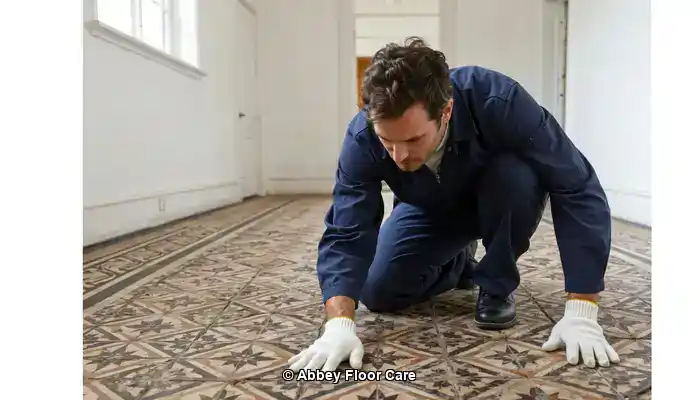
Last Updated on October 30, 2025 by David
Unlocking the Secrets to Revitalising Faded Victorian Mosaic Tiles
- Victorian mosaic tiles frequently lose their colour due to embedded dirt, aging coatings, and surface wear, which occur from factors beyond just the passage of time. The accumulation of grime and neglect contributes significantly to the visual deterioration of these historical pieces.
- Steering clear of harsh chemicals and aggressive scrubbing is crucial, as these methods can strip original pigments, particularly from encaustic and geometric tiles. Instead, a gentle touch and careful techniques should be employed to preserve the inherent beauty of the tiles.
- Initiating safe restoration starts with a comprehensive cleaning process that utilises pH-neutral solutions and low-speed rotary machines fitted with soft brushes, effectively eliminating dirt without causing harm to the tile surface. This method ensures a delicate yet thorough approach to cleaning.
- Careful removal of outdated sealers and waxes is essential to reveal the true condition of the tile surface, allowing restorers to assess the extent of fading and wear accurately.
- Enhancing colour can be accomplished with breathable, stone-safe sealers that enrich the hues of the tiles without leaving a glossy film, thus maintaining their traditional aesthetic while providing necessary protection.
- Engaging professional restoration services rejuvenates the original pigments without resorting to repainting or artificial colouring, ensuring the authenticity of the tiles remains intact and cherished for years to come.
- Maintaining restored tiles requires gentle cleaning routines and the avoidance of products containing acid or bleach, as these substances can damage the restored surface and compromise the integrity of the tile.
- Heritage-sensitive methods are essential in safeguarding both the aesthetic appeal and historical significance of the tiles, ensuring that the restoration process adheres to best practices and respects the original craftsmanship.
Understanding the Importance of Restoring Victorian Tiles for Future Generations
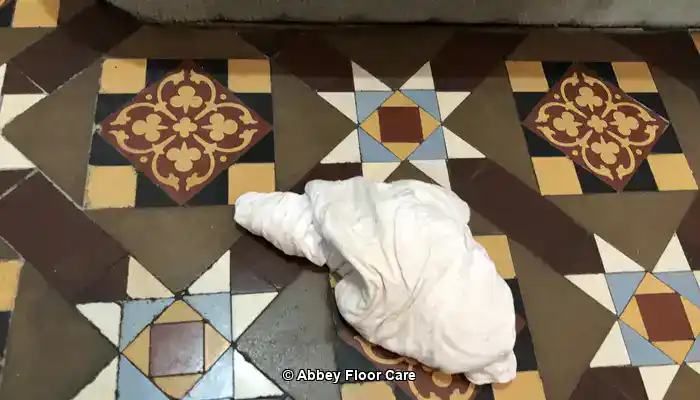
Abbey Floor Care restoring the colour to a Victorian clay tile floor using a colour-enhancing impregnating sealer.
Victorian encaustic and mosaic tiles are a fundamental element of British architectural heritage, renowned for their intricate craftsmanship and distinctive colour palettes formed from mineral pigments embedded directly into the clay tile bodies. The artistry, craftsmanship, and meticulous attention to detail encapsulated in these tiles reflect the cultural values and aesthetic preferences of the Victorian era, making their preservation crucial for the enjoyment of future generations. By safeguarding these tiles, we ensure that the stories they tell and the beauty they embody continue to inspire and educate those who encounter them.
Pro Tip: Optimal Products for Daily Care of Victorian Tiles
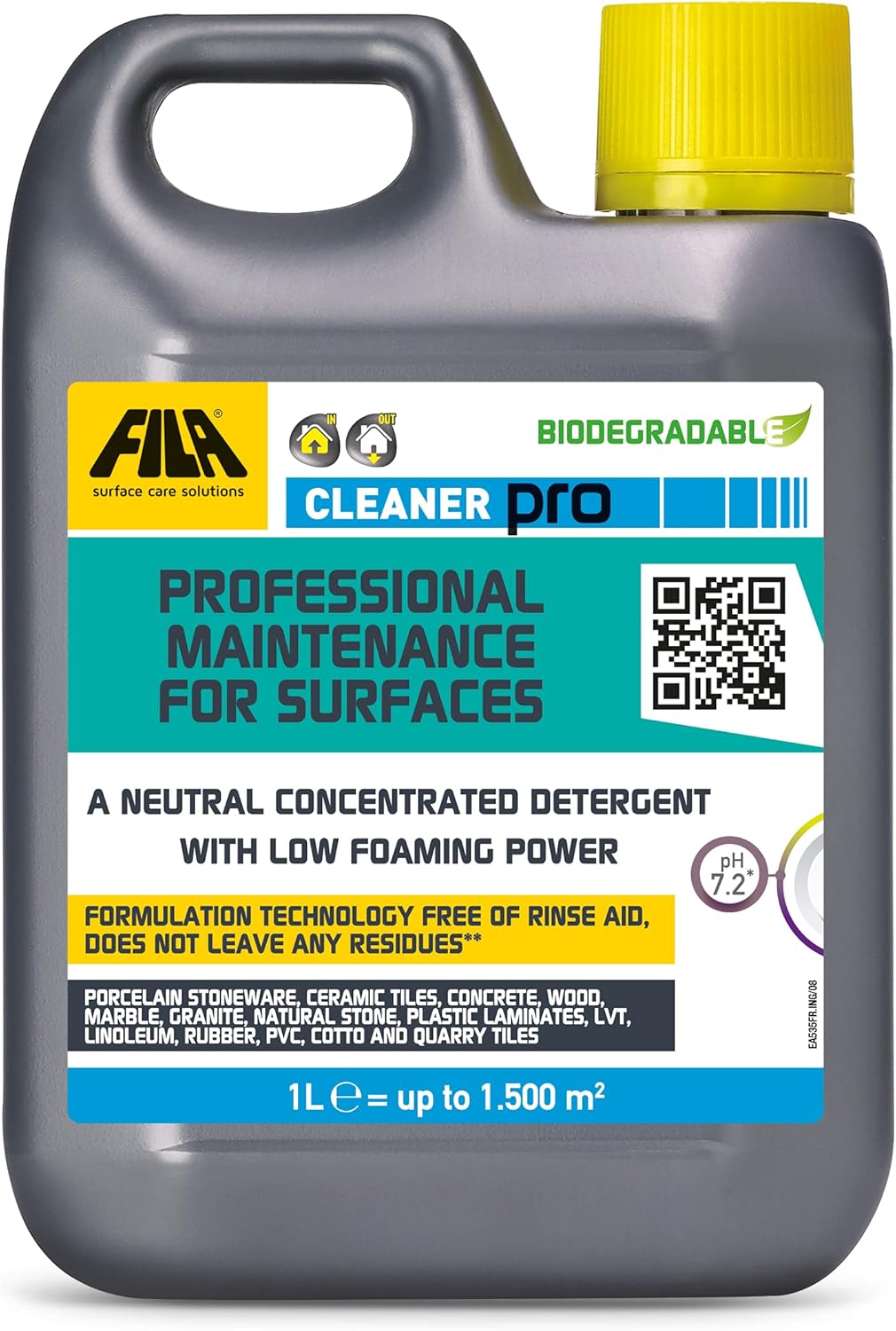
Fila Pro Floor Cleaner
|

LTP Colour Intensifier & Stainblock H20
|

Vileda H2PrO Spin Mop System
|
Over time, however, the exquisite nature of these tiles can diminish due to surface wear, chemical reactions, and various environmental factors. The process of restoring their original vibrancy necessitates specialists who possess a comprehensive understanding of the materials, historically accurate techniques, and the use of premium products. Engaging skilled professionals ensures that the restoration process respects the integrity of the tiles while enhancing their visual qualities and revitalising their appeal, thus ensuring these historical treasures are cherished for generations.
Identifying Factors Behind the Fading of Victorian Mosaic Tiles and Surface Dulling

Example of Victorian Clay Tile Floor dulled through surface wear and damage.
While the pigments are integral to the tile’s composition, various factors contribute to fading and dulling, including:
- Accumulated dirt and grime: Continuous foot traffic introduces fine particles and oils that penetrate porous surfaces, scattering light and muting vibrant colours, leading to a less appealing appearance over time.
- Wax and polish buildup: Layers of non-breathable wax or sealants trap moisture, resulting in a cloudy or yellowed appearance that obscures the beauty of the tiles as time progresses.
- Moisture-related issues: Many Victorian tiles were installed over subfloors lacking damp-proof membranes, which leads to rising damp that transports soluble salts. These salts crystallise on the tile surface as efflorescence, further obscuring the original tones and rich colours of the tiles.
- Physical abrasion: Small surface scratches from years of wear disrupt smooth light reflection, diminishing the overall visual richness and appeal of the tiles, making restoration even more critical.
Effective restoration systematically addresses each of these contributing factors without compromising the historic integrity of the tile, ensuring they regain their former glory and continue to serve as a testament to the craftsmanship of their era.
The Critical Role of Breathability in the Absence of Damp-Proof Membrane
As many Victorian tiled floors are situated over older subfloors that lack a damp-proof membrane (DPM), it is essential for their natural clay structure to remain permeable. This permeability allows moisture to evaporate from the subfloor effectively. Non-breathable wax coatings or film-forming sealers obstruct this vital evaporation pathway, leading to moisture accumulation beneath the surface. Such entrapment of salts and humidity can result in efflorescence, degradation of surface minerals, and the unwelcome phenomenon known as wax blooming—a whitish haze on the tiles. Restoration plans must prioritise breathable impregnating sealers that protect the tiles while allowing moisture vapour to escape freely, thus preventing long-term damage and ensuring the tiles remain in the best condition possible.
In-Depth Exploration of Pigments and the Composition of Victorian Tiles for Effective Restoration
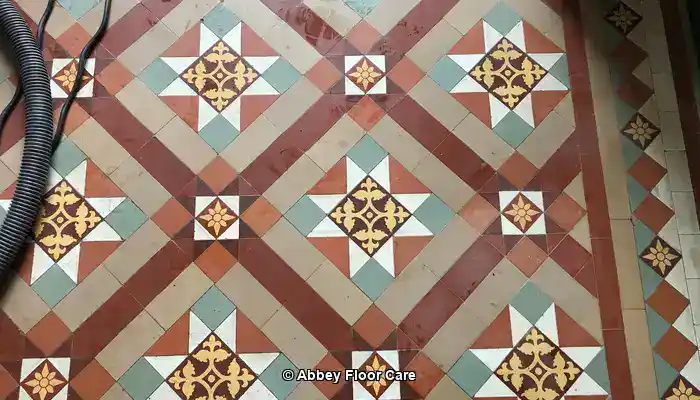
An example of different pigments in a Victorian Clay tile floor during restoration by Abbey Floor Care
Exploring the Role of Mineral Oxide Pigments in Victorian Tiles
Victorian mosaic and encaustic tiles acquire their distinctive earthy colours from mineral oxide pigments embedded directly into the clay. These pigments contribute not only to durability but also to enhanced colour depth and vibrancy. The primary pigments typically include:
- Iron oxide: generates terracotta reds, warm rust browns, and soft ochres, providing a rich foundation for the colour scheme.
- Manganese: leads to deep browns and rich black tones, adding depth and contrast to the overall aesthetic.
- Cobalt: infuses a range of blue hues, creating visual interest and variety within tile patterns.
- Chromium: produces natural green shades, contributing to the unique palette that defines many Victorian tile designs.
The Firing and Fusion Process in Tile Manufacturing
During the manufacturing process, tiles undergo firing at temperatures around 1100°C, a method that vitrifies the clay and fuses the pigments deep within the tile body. This technique ensures that the colour is inherent throughout the tile rather than merely residing on the surface, resulting in long-lasting vibrancy and visual appeal. The high-temperature firing process also enhances the durability of the tiles, making them resilient to wear and tear over time.
The Characteristics of Porous Unglazed Finish in Victorian Tiles
Typically, Victorian tiles feature a porous, unglazed matte finish, which enhances their natural appearance. However, this porosity renders the tiles absorbent and sensitive to surface contamination and moisture, necessitating careful cleaning and maintenance practices to preserve their condition and longevity. Understanding these characteristics is crucial for anyone involved in the restoration process, as it dictates the techniques and products that should be used to ensure optimal results.
Understanding Variability in Colour Durability Among Different Tiles
Natural earth pigments, especially in red and yellow tiles, often contain fewer mineral additives compared to their darker counterparts, such as black tiles, which typically use manganese. This difference means that red and yellow tiles tend to be less durable and more prone to surface dishing under heavy traffic. This wear manifests as shallow depressions where foot traffic is concentrated, leading to uneven colour intensity and a loss of surface flatness over time. Recognising these variances allows restorers to tailor their approaches to each specific tile type.
Key Considerations for Successful Restoration of Victorian Tiles
A comprehensive understanding of pigment composition and wear patterns is vital when planning a restoration. Softer-toned tiles require gentler cleaning methods and specially tailored impregnating sealers that respect their physical properties while enhancing colour. In contrast, darker, more durable tiles can withstand more intensive cleaning but still require breathable, colour-enhancing protection to maintain their vibrancy and visual appeal over time. This knowledge is essential for achieving successful and lasting restoration outcomes.
Implementing Effective Cleaning Techniques for Victorian Mosaic Tiles
Achieving effective cleaning is crucial for restoring Victorian encaustic and mosaic tiles to their original vibrancy. However, the cleaning of these tiles requires a specialised approach that extends beyond the simple use of pH-neutral detergents typically recommended. Professional restorers leverage specifically formulated alkaline cleaners and mechanical techniques to effectively dismantle heavy soiling and old residues without jeopardising the historic fabric of the tiles. A well-planned cleaning strategy is vital for ensuring the tiles can be restored without compromising their integrity.
Thorough Removal of Debris and Loose Dirt from Tile Surfaces
The cleaning process commences with the removal of all loose dirt and grit, accomplished using soft brushes or vacuuming with brush attachments. This initial step is critical in preventing scratches on the delicate tile surfaces during subsequent cleaning stages, ensuring that the integrity and visual quality of the tiles are maintained throughout the entire process. By effectively removing loose debris, restorers set the stage for deeper cleaning techniques to be applied safely.
Utilising Alkaline Cleaners for Intensive Soil Removal from Victorian Tiles
Unlike pH-neutral cleaners, which often lack the necessary chemical potency to combat ingrained fatty acids and organic soils, alkaline cleaners are essential for thoroughly breaking down household oils, grease, and sticky residues that are frequently present on tile surfaces and in grout lines. These alkaline formulations dissolve the binding agents of dirt, sugars, and fats, allowing for effective removal while maintaining compatibility with the mineral composition of Victorian tiles. Skilled restorers often use professional-grade alkaline products, such as PS87 PRO or custom formulations provided by heritage cleaning specialists, in diluted form to ensure a deep clean without excessive aggression towards the clay body.
It is crucial to remember that, even with alkaline cleaners, caution is necessary, and spot testing is always recommended prior to full application to avoid any potential damage. This methodical approach ensures that the cleaning process is both safe and effective, preserving the beauty of the tiles.
Implementing Mechanical Agitation with Suitable Pads for Cleaning
Mechanical action significantly enhances cleaning effectiveness. Low-speed rotary scrubbers fitted with red or, in some cases, green non-abrasive pads are commonly employed to agitate soils from small pits, tile surfaces, and grout lines. These pads thoroughly clean while safeguarding the integrity of tile edges and delicate surface details, making them indispensable tools in the restoration process. The careful use of mechanical agitation prevents damage while ensuring that all areas of the tile receive the attention they need for a complete clean.
Targeted Removal of Waxes and Inappropriate Sealants from Tiles
Years of usage often lead to the accumulation of old waxes and sealants, particularly from DIY attempts that utilised unsuitable products. Water-based cleaners—whether alkaline or mildly acidic—are preferred for effectively removing these residues without damaging the mineral structure of the tiles. However, stubborn ‘exotic’ or solvent-resistant coatings may necessitate the use of targeted solvent-based removers such as Lithofin Wax-Off or LTP Solvex. These solvents effectively soften and emulsify waxes and old sealants but must be handled with caution, requiring professionals trained in their safe application and disposal methods. This diligence ensures that the restoration process is efficient and safe for the tiles.
Thorough Rinsing and Drying Procedures After Cleaning
Following chemical cleaning, thorough rinsing is paramount to eliminate all cleaning residues. Multiple rinses with clean water, supplemented by wet vacuum extraction, ensure that no detergent or solvent remnants remain, which could interfere with subsequent restoration coatings. The drying time is contingent upon environmental conditions, such as humidity, surface type, and moisture levels. Restoration experts invariably use moisture meters to verify that the tiles are completely dry before applying any impregnating sealers or protective treatments. This meticulous approach prevents moisture entrapment, which could lead to efflorescence, staining, or damage beneath sealed layers.
The Benefits of Comprehensive Cleaning for Victorian Tiles
Thorough cleaning unveils the actual condition of the tiles by eliminating visual obstructions. This process exposes areas that may require repair and provides a clean, receptive surface for colour-enhancing impregnators or other restorative products. Such careful preparation is fundamental to the success and longevity of Victorian mosaic tile restoration, ensuring that the tiles can be enjoyed for many years to come. By revealing the true condition of the tiles, restorers can make informed decisions about the best methods and materials to use in the restoration process.
Enhancing Colour with High-Quality Impregnating Sealers for Victorian Tiles
Restorers utilise impregnating colour-enhancing sealers manufactured by LTP and Lithofin, brands celebrated for their advanced, heritage-approved formulations. Unlike superficial coatings, these sealers:
- Penetrate deeply into tile pores to enrich colour by changing light refraction, enhancing the tile’s visual appeal significantly.
- Maintain vapour permeability, which is essential for moisture escape—a critical factor in older floors lacking DPM layers, preventing long-term damage.
- Provide durable protection against stains and foot traffic without altering the natural texture or gloss of the tiles, preserving their historical integrity.
- Applied in multiple light coats, with each layer allowed to penetrate fully before the next is applied, ensuring uniformity and even coverage for optimal results.
These sealers directly combat fading by restoring vibrancy while preserving the breathable nature of the historic floor, contributing to long-term maintenance of the tiles’ beauty and ensuring they remain a cherished feature of any space.
Repairing Damaged Tiles with Colour Tinting Techniques for Authentic Restoration
Tiles that display chips, cracks, or missing pieces require meticulous repair using tinted epoxy or lime-based mortars, colour-matched with natural mineral oxides. Restoration experts often source matching replacement tiles from salvage archives to ensure pattern continuity and authenticity. Colour tinting involves the selective application of earth-pigment-infused wax or resin mixtures to seamlessly blend worn or missing pattern areas while respecting the tiles’ breathability and reversibility, ensuring a professional finish that maintains the tiles’ historical significance.
Best Practices for Effective Colour Tinting of Tiles
- Utilise small, controlled applications to prevent excessive colouring and ensure a natural appearance, maintaining the integrity of the original design.
- Conduct patch testing on inconspicuous areas prior to full application to assess compatibility and ensure the desired results.
- Ensure compatibility with the impregnating sealers applied across the entire surface to maintain cohesion and longevity, preventing any adverse reactions.
Essential Ongoing Maintenance for Restored Victorian Mosaic Floors
To preserve the restored colour and condition of Victorian mosaic tiles, ongoing care is paramount. Implementing a regular maintenance routine includes:
- Regular cleaning with pH-neutral, non-abrasive detergents specifically formulated for historic tiles, ensuring that the tiles remain in optimal condition.
- Implement preventive measures, such as placing entrance mats, to minimise dirt ingress and protect the tile surface from wear and tear.
- Prompt removal of liquid spills, especially acidic substances like vinegar or wine, to avert surface etching and damage to the tiles.
- Reapply breathable impregnating sealers every 3 to 5 years or as wear dictates to maintain protective integrity and visual appeal, ensuring long-lasting beauty.
- Monitor floors for signs of efflorescence or moisture ingress, which may indicate underlying damp issues that need immediate addressing to prevent further damage.
Avoiding Common Pitfalls in Tile Restoration Practices
- Avoid wax treatments that can obstruct breathability, cause efflorescence, or lead to wax blooming, which diminishes visual quality and longevity of the tiles.
- Steer clear of using acrylic or polyurethane sealants that trap moisture, ultimately degrading the tiles over time and causing irreparable damage.
- Limit the use of harsh chemical cleaners, as they can erode clay and pigments, damaging the tile’s integrity and appearance significantly.
- Never repaint tiles; paint films alter their visual and physical properties and are not reversible, leading to long-term issues that compromise the tiles.
- Identify and address problems in older subfloors before sealing to ensure a stable foundation for the tiles, safeguarding against future complications and ensuring the longevity of the restoration work.
Showcasing Successful Restoration Projects of Victorian Tiles
Real-world examples illustrate the effective application of these principles in tile restoration:
A Victorian Hallway Restoration Project in Sheffield
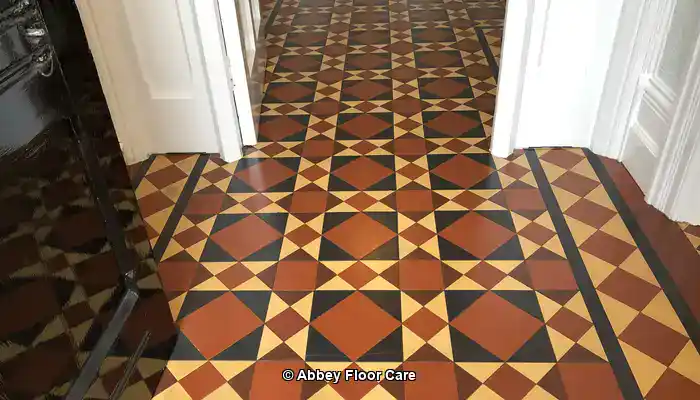
Our cleaning methodology effectively eliminated years of wax and grime, followed by the application of a Lantania Avo colour-enhancing impregnating sealer that visibly deepened the tile colours. To further safeguard the surface, we applied an acrylic topical sealer, ensuring durability on floors installed over a damp-proof membrane. This project exemplifies the successful restoration of Victorian tiles, bringing them back to life while respecting their historical significance.
A Restored Civic Mosaic Floor in Chesterfield

After the cleaning process and removal of old topical sealers, the floor was sealed with an LTP Colour Enhancing Impregnating sealer, followed by the careful application of a wax that seamlessly integrated the clay tiles into the historic fabric of the building. This meticulous approach highlights the importance of preserving the character and integrity of Victorian mosaics while ensuring they remain functional and beautiful.
Preserving Our Heritage Through Expert Restoration Techniques for Victorian Tiles
Restoring the colour and pigment of Victorian mosaic tiles is a multifaceted endeavour that intertwines material science, craftsmanship, and sensitivity to heritage values. By employing premium impregnating colour-enhancing sealers from industry leaders such as Dry Treat, Lantania, and Lithofin, restorers ensure long-term breathability, protection, and colour vibrancy. Skilled cleaning, meticulous repair, and committed maintenance practices uphold authenticity while rejuvenating these historic floors for future generations to admire and enjoy, ensuring their legacy endures for years to come.
Your Questions Answered: Frequently Asked Questions (FAQs) on Tile Restoration
What defines Victorian mosaic tiles and their unique features?
Victorian mosaic tiles are decorative tiles that gained prominence during the 19th century, celebrated for their vibrant colours and intricate patterns. Frequently utilised in public buildings and private homes, they showcase the aesthetics and craftsmanship of the era, reflecting the cultural and historical context of their time.
How can I effectively restore faded Victorian mosaic tiles to their original splendour?
Restoring faded Victorian mosaic tiles involves several steps, including comprehensive cleaning, repairing any damage, applying new pigments to match the original colours, and sealing the tiles to protect them from future wear and environmental factors. This careful process ensures that the tiles regain their former beauty and remain a valuable part of architectural history.
Which materials are essential for tile restoration to ensure quality results?
Essential materials for tile restoration include specialised cleaning solutions, pigments, adhesives, grout, and protective sealants, all selected for their compatibility with the original tiles to ensure effective and lasting restoration. Using the right materials is crucial in achieving a successful outcome that respects the tiles’ integrity.
What is the typical duration for the tile restoration process to be completed?
The duration of tile restoration can vary significantly based on the size and condition of the area being restored, with timelines typically ranging from a few days for smaller projects to several weeks for more extensive restorations. Careful planning and execution are necessary to ensure high-quality results.
Can I handle the restoration myself, or should I hire a professional?
Yes, smaller restoration projects can be tackled as a DIY task if you possess the necessary skills and tools. However, more complex repairs require professional expertise to ensure high-quality results and maintain historical integrity, making it advisable to consult experts for significant restoration efforts.
What is the approximate cost of restoring Victorian mosaic tiles?
Costs for tile restoration can vary greatly depending on the project’s size and condition, ranging from a few hundred to thousands of pounds for comprehensive restoration efforts that respect the tiles’ heritage. Understanding the potential costs involved helps in planning and budgeting for restoration projects.
How do I select the right restoration expert to trust with my tiles?
When choosing restoration professionals, seek those with experience in historical projects, positive reviews, and a commitment to using authentic materials and techniques that honour the original craftsmanship of Victorian tiles. This due diligence ensures that your restoration project is handled by qualified and knowledgeable experts.
What challenges do restorers commonly face during the restoration process?
Restorers often encounter challenges such as matching original colours, repairing damaged tiles, and ensuring the longevity of the restoration work. These issues require careful planning and execution to achieve satisfactory results while preserving the tiles’ historical significance.
How can I maintain my restored tiles effectively to ensure their longevity?
To maintain restored tiles, engage in regular cleaning with pH-neutral products, avoid harsh chemicals, periodically reseal the tiles, and promptly address any damage that may occur to preserve their beauty and integrity. Establishing a maintenance routine will ensure that your tiles remain in excellent condition for years to come.
What innovations are emerging in tile restoration practices today?
Recent innovations in tile restoration include advanced cleaning solutions, novel types of sealants, and the application of digital technology for precise colour matching and pattern replication within restoration projects. Staying informed about these advancements can aid restorers in achieving superior results.
The Article Restoring Colour and Pigment to Faded Victorian Mosaic Tiles was first found on https://www.abbeyfloorcare.co.uk
The Article Restoring Faded Victorian Mosaic Tiles to Their Original Colour appeared first on https://fabritec.org
The Article Restoring Victorian Mosaic Tiles to Their Original Color Was Found On https://limitsofstrategy.com
The Article Restoring Original Colour of Victorian Mosaic Tiles First Appeared ON
: https://ad4sc.com


